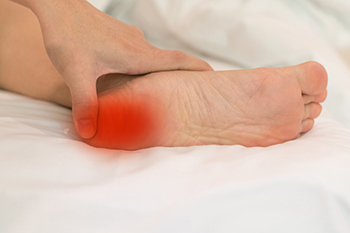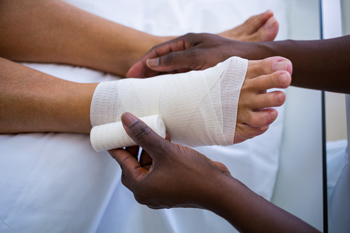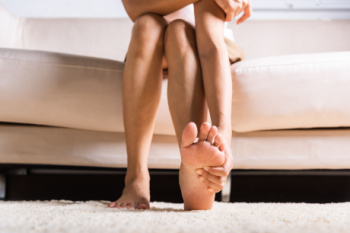Connect With Us
Blog
Items filtered by date: December 2024
Treating Sever’s Disease

Sever’s disease, or calcaneal apophysitis, is a common cause of heel pain in growing children, typically between ages eight and 14. It occurs when the growth plate in the heel becomes inflamed due to repetitive stress. This condition is often seen in active kids participating in sports like soccer, basketball, or gymnastics, where running and jumping place pressure on the heel. The pain usually develops at the back or underside of the heel and worsens during activity. Swelling and tenderness may also be present. Diagnosing Sever’s disease involves a physical exam and ruling out other causes of heel pain. Treatment focuses on reducing inflammation and relieving discomfort. Rest, stretching exercises, and wearing supportive footwear are often recommended. If your child has persistent heel pain, it is suggested that you visit a podiatrist for a proper diagnosis and treatment, which may include orthotics.
Sever's disease often occurs in children and teens. If your child is experiencing foot or ankle pain, see Richard M. Allen, DPM from Idaho. our doctor can treat your child’s foot and ankle needs.
Sever’s Disease
Sever’s disease is also known as calcaneal apophysitis, which is a medical condition that causes heel pain I none or both feet. The disease is known to affect children between the ages of 8 and 14.
Sever’s disease occurs when part of the child’s heel known as the growth plate (calcaneal epiphysis) is attached to the Achilles tendon. This area can suffer injury when the muscles and tendons of the growing foot do not keep pace with bone growth. Therefore, the constant pain which one experiences at the back of the heel will make the child unable to put any weight on the heel. The child is then forced to walk on their toes.
Symptoms
Acute pain – Pain associated with Sever’s disease is usually felt in the heel when the child engages in physical activity such as walking, jumping and or running.
Highly active – Children who are very active are among the most susceptible in experiencing Sever’s disease, because of the stress and tension placed on their feet.
If you have any questions, please feel free to contact our office located in Lewiston, ID . We offer the newest diagnostic and treatment technologies for all your foot and ankle injuries.
Common Causes of Ankle Popping

Ankle popping, medically referred to as crepitus, can occur for a variety of reasons, but is usually harmless unless accompanied by pain or swelling. Common causes of ankle popping include the release of gas within the joint capsule, which produces a popping sound without pain. Issues with the tendons surrounding the ankle, such as peroneal tendonitis, may also cause popping. Such tendon inflammation may also cause pain and instability, particularly during movement. Ligament injuries, such as ankle sprains, can also result in a popping noise, often at the time of injury, along with swelling and bruising. Damage to cartilage in the ankle may lead to clicking sounds and joint instability during activity. Incorporating specific exercises to strengthen the muscles and improve ankle mobility, such as ankle circles or calf raises, can help support the joint and reduce the risk of further complications. A podiatrist can assess the cause of ankle popping and develop a plan to address the underlying issue. If your ankles make a popping sound, it is suggested that you schedule an appointment with a podiatrist for an exam and treatment options.
Ankle pain can be caused by a number of problems and may be potentially serious. If you have ankle pain, consult with Richard M. Allen, DPM from Idaho. our doctor will assess your condition and provide you with quality foot and ankle treatment.
Ankle pain is any condition that causes pain in the ankle. Due to the fact that the ankle consists of tendons, muscles, bones, and ligaments, ankle pain can come from a number of different conditions.
Causes
The most common causes of ankle pain include:
- Types of arthritis (rheumatoid, osteoarthritis, and gout)
- Ankle sprains
- Broken ankles
- Achilles tendonitis
- Achilles tendon rupture
- Stress fractures
- Bursitis
- Tarsal tunnel syndrome
- Plantar fasciitis
Symptoms
Symptoms of ankle injury vary based upon the condition. Pain may include general pain and discomfort, swelling, aching, redness, bruising, burning or stabbing sensations, and/or loss of sensation.
Diagnosis
Due to the wide variety of potential causes of ankle pain, podiatrists will utilize a number of different methods to properly diagnose ankle pain. This can include asking for personal and family medical histories and of any recent injuries. Further diagnosis may include sensation tests, a physical examination, and potentially x-rays or other imaging tests.
Treatment
Just as the range of causes varies widely, so do treatments. Some more common treatments are rest, ice packs, keeping pressure off the foot, orthotics and braces, medication for inflammation and pain, and surgery.
If you have any questions, please feel free to contact our office located in Lewiston, ID . We offer the newest diagnostic and treatment technologies for all your foot care needs.
Expert Diabetic Wound Care Matters

Diabetic foot disease, or DFD, is a serious complication of diabetes that significantly impacts quality of life. Its prevalence has increased due to predisposing factors such as prolonged high blood sugar levels, poor circulation, and impaired immune function. These factors heighten the risk of infections, slow wound healing, and contribute to conditions like diabetic neuropathy, which reduces sensation in the feet. This loss of feeling can lead to unnoticed injuries that develop into diabetic foot ulcers, a common precursor to lower limb amputations. Without proper care, these ulcers can become severely infected, making amputation necessary to prevent life-threatening complications. Podiatrists play a critical role in managing diabetic foot wounds, utilizing advanced treatments such as debridement, specialized dressings, and offloading devices to promote healing and prevent recurrence. If you have diabetes,it is suggested that you schedule regular podiatric appointments to reduce the risks associated with diabetic foot disease.
Wound care is an important part in dealing with diabetes. If you have diabetes and a foot wound or would like more information about wound care for diabetics, consult with Richard M. Allen, DPM from Idaho. our doctor will assess your condition and provide you with quality foot and ankle treatment.
What Is Wound Care?
Wound care is the practice of taking proper care of a wound. This can range from the smallest to the largest of wounds. While everyone can benefit from proper wound care, it is much more important for diabetics. Diabetics often suffer from poor blood circulation which causes wounds to heal much slower than they would in a non-diabetic.
What Is the Importance of Wound Care?
While it may not seem apparent with small ulcers on the foot, for diabetics, any size ulcer can become infected. Diabetics often also suffer from neuropathy, or nerve loss. This means they might not even feel when they have an ulcer on their foot. If the wound becomes severely infected, amputation may be necessary. Therefore, it is of the upmost importance to properly care for any and all foot wounds.
How to Care for Wounds
The best way to care for foot wounds is to prevent them. For diabetics, this means daily inspections of the feet for any signs of abnormalities or ulcers. It is also recommended to see a podiatrist several times a year for a foot inspection. If you do have an ulcer, run the wound under water to clear dirt from the wound; then apply antibiotic ointment to the wound and cover with a bandage. Bandages should be changed daily and keeping pressure off the wound is smart. It is advised to see a podiatrist, who can keep an eye on it.
If you have any questions, please feel free to contact our office located in Lewiston, ID . We offer the newest diagnostic and treatment technologies for all your foot care needs.
Blisters Between the Toes

Blisters between the toes are often caused by friction, moisture, or infections. They can be painful and make walking uncomfortable. Symptoms include redness, swelling, and fluid-filled pockets that may burst and cause irritation. Among the causes of blisters are allergies to certain shoes or materials, fungal infections like athlete's foot, or poorly fitting shoes that create friction. Fungal infections often occur in damp environments and may lead to itching, cracking, and peeling skin between the toes. Allergies to shoe materials or detergents can also trigger blisters. Tight shoes or socks that trap moisture can worsen friction, increasing the likelihood of blisters forming. Treatment depends on the underlying cause. For fungal infections, antifungal creams or powders can help, while wearng proper shoes and moisturizing can prevent friction-related blisters. A podiatrist can assess your condition and recommend the best treatment, whether it is antifungal therapy or advice on proper footwear. If you are struggling with blisters between your toes, it is suggested that you schedule an appointment with a podiatrist for professional care and advice.
Blisters are prone to making everyday activities extremely uncomfortable. If your feet are hurting, contact Richard M. Allen, DPM of Idaho. our doctor can provide the care you need to keep you pain-free and on your feet.
Foot Blisters
Foot blisters develop as a result of constantly wearing tight or ill-fitting footwear. This happens due to the constant rubbing from the shoe, which can often lead to pain.
What Are Foot Blisters?
A foot blister is a small fluid-filled pocket that forms on the upper-most layer of the skin. Blisters are filled with clear fluid and can lead to blood drainage or pus if the area becomes infected.
How Do Blisters Form?
Blisters on the feet are often the result of constant friction of skin and material, usually by shoe rubbing. Walking in sandals, boots, or shoes that don’t fit properly for long periods of time can result in a blister. Having consistent foot moisture and humidity can easily lead to blister formation.
Prevention & Treatment
It is important to properly care for the affected area in order to prevent infection and ease the pain. Do not lance the blister and use a Band-Aid to provide pain relief. Also, be sure to keep your feet dry and wear proper fitting shoes. If you see blood or pus in a blister, seek assistance from a podiatrist.
If you have any questions, please feel free to contact our office located in Lewiston, ID . We offer the newest diagnostic and treatment technologies for all your foot care needs.
Get Proper Treatment for Ankle Injuries
CRPS and Foot Pain

Complex Regional Pain Syndrome, or CRPS, is a chronic pain condition that can severely impact the feet, causing intense discomfort, swelling, and skin changes. CRPS often develops after an injury, surgery, or trauma, even if minor, when the nervous system overreacts, leading to persistent pain far beyond the original injury site. In the feet, CRPS may cause burning pain, heightened sensitivity to touch, temperature fluctuations, and skin color changes. The affected foot can become swollen and stiff, making movement difficult and sometimes causing muscle weakness. CRPS is most common in adults, but anyone with an injury may be at risk. Early diagnosis is important to manage symptoms effectively, often involving medications, targeted exercises, and nerve treatments. If you suffer from CRPS, it is suggested that you consult a podiatrist who can help improve function and prevent the condition from worsening.
Some foot conditions may require additional professional care. If you have any concerns, contact Richard M. Allen, DPM of Idaho. our doctor can provide the care you need to keep you pain-free and on your feet.
Rare Foot Conditions
The majority of foot conditions are common and can be treated by a podiatrist. Standard diagnostic procedures are generally used to identify specific conditions and treatment can be rendered. A podiatrist also treats rare foot conditions which can be difficult to diagnose and may need extra attention and care.
There are many rare foot conditions that can affect children. Some of these can include:
- Freiberg’s disease
- Kohler’s disease
- Maffucci syndrome
Freiberg’s disease - This can be seen as a deterioration and flattening of a metatarsal bone that exists in the ball of the foot. It typically affects pre-teen and teenage girls, but can affect anyone at any age. Symptoms that can accompany this can be swelling, stiffness, and the patient may limp.
Kohler’s disease - This often targets the bone in the arch of the foot and affects younger boys. It can lead to an interruption of the blood supply which ultimately can lead to bone deterioration. The patient may limp or experience tenderness, swelling, and redness.
Maffucci syndrome - This affects the long bones in a child’s foot leading to the development of abnormal bone lesions. They are benign growths and typically develop in early childhood and the bones may be susceptible to breaking.
A podiatrist can properly diagnose and treat all types of rare foot conditions. If your child is affected by any of these symptoms or conditions, please don’t hesitate to call our office so the correct treatment method can begin.
If you have any questions please feel free to contact our office located in Lewiston, ID . We offer the newest diagnostic tools and technology to treat your foot and ankle needs.

